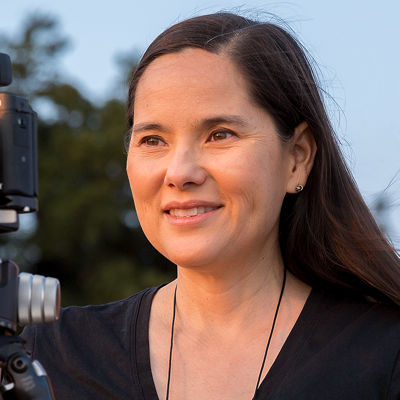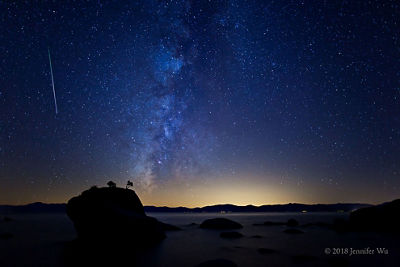
When we were little, every summer my Dad would take my sister and I backpacking. He carried all the gear, while we were left to carry the most important things: our stuffed animals and water bottles. One year, driving back at night after a long day of backpacking on our way out of the mountains in the Eastern Sierra, California, my Dad pulled over to watch a meteor shower. We laid on the ground looking up at the sparkling night sky. There were so many meteors, one after another. I was in awe and amazed. When we saw a shooting star, my dad would say, “Make a wish.” I was so happy that night because I got to make dozens of wishes!
What is a Meteor?
Based on my research, meteoroids are mostly metal and stone debris coming from the icy comets within our solar system. Millions of small meteoroids enter our atmosphere daily, often the size of a grain of sand or a pebble, and then burn up before reaching the surface. The heat from friction in the atmosphere burns them up with the resulting gas creating a bright ionizing trail of light in their path. This intense blaze of light falling from the sky is why we’ve come to call them falling stars or shooting stars. A meteor that makes it all the way through the atmosphere and impacts the ground is called a meteorite. [1]
What Creates a Meteor Shower?
Comets and their meteoroids orbit the sun in elliptical paths. When a comet and a large group of meteoroids pass into the earth’s atmosphere, they create a meteor shower with many meteoroids entering our atmosphere, lighting up the night sky in a mesmerizing display of streaking light. Each annual meteor shower has a comet or asteroid associated with it. Meteor showers emanate from a particular star or constellation, and that’s where their name comes from.
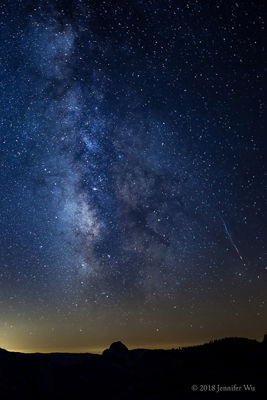
Ideal Viewing Conditions
In this article I will provide tips on how to photograph meteors based on my experience so that you can learn from my mistakes. I find it disappointing when going out to photograph meteors to find visibility reduced due to thin cloud cover or other factors. It is possible to see meteors on any night with ideal viewing conditions. Atmospheric conditions including light pollution, weather and the phase of the moon determine meteor visibility so here are some things to consider.
• Light Pollution
For the best viewing opportunities, you’ll need to get away from the light pollution found in larger towns and cities. I like driving a couple of hours outside of city lights. Use the Light Pollution Map to locate dark skies—avoid red, orange and yellow areas and look for gray, blue or green areas. I find these provide dark skies. Distant city lights provide a warm, sunset-like glow along the horizon. Plan on photographing in the direction of a city for the warm glow or away from it for darker skies, depending on your preference.
• Cloud Cover
Clear skies with low humidity, low dust and few clouds improve meteor visibility. For your area, you can check for cloud cover monthly averages at Weather Spark. For cloud cover predictions for the next 24-48 hours at Clear Sky Chart (my favorite) or a map view at 7Timer!, click on weather chart, desired map and cloud cover.
• Moon Phase
Photographing near the new moon phase, when no moon is visible in the sky, allows for dark sky conditions and more visible stars. The bright meteors will be even more spectacular and dim meteors will be photographable. Based on my experience photographing meteors, I recommend shooting within a week before or after a new moon for dark skies and bright meteors. The half-moon will supply bright light on the landscape and work relatively well but is not ideal. Avoid the light of the three-quarter moon or the full moon, as it is very disappointing. Look up the phase of the moon using the resources listed at the end of this article.
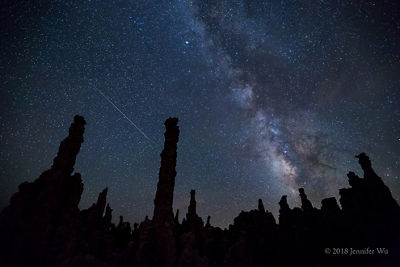
Exposure Settings for Meteors
Photographing meteors is very much the same as photographing the stars as points of light and the Milky Way. For settings and equipment, please first read my article Photographing the Milky Way and Night Sky and use the camera settings checklist. Read the section on when to photograph the Milky Way to apply it to your meteor shots.
The shutter speeds of 15-30 seconds are good for meteors. I discovered longer exposure times of a few minutes, like with star trails, meteors become dim or invisible.
Meteors start as green, turn yellow and end in red, but the red can appear white due to overexposure. I noticed I could underexpose the night sky to get better color in a meteor but I did not like that the night sky and dim meteors were underexposed. If you do this, take a base layer image with a good exposure of the stars, twilight or both. Then use Photoshop® as described later in this article to composite a properly exposed base layer of the stars with the underexposed meteor layer.
Long Exposure Noise Reduction - LENR
Turn off LENR. In my testing, it does very little for a 30-second exposure to reduce the digital noise but works well with longer exposures. Using LENR will double the time of your exposure since it uses a second exposure to determine the fixed-pattern noise to subtract from the actual exposure. Turning it off will double your chances of photographing a meteor. I made the mistake of leaving it on when photographing a meteor shower and I missed some good meteor shots.
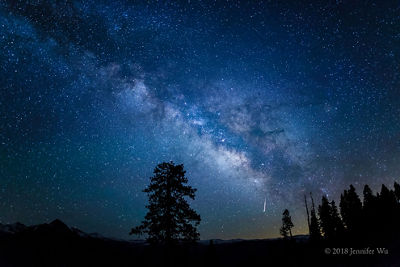
Lens Selection
Wide-angle lenses are perfect for a broad area of view to capture a meteor. I use from 14mm to 35mm depending on the composition for the scene. Using an ultra wide-angle lens like a 14mm versus a 24mm will allow for a broader area of coverage and more likeliness of including a meteor in your frame. However, the meteor will appear smaller in the frame so use your best judgment given your scene.
Time-lapse
I have some beautiful but flawed meteor photos because they have a poor composition due to the meteor’s positioning within the frame. To increase your chances of getting a meteor composition you are happy with, set up your camera to do time-lapse and take photographs continuously over a period of time, such as a few hours. A time-lapse will have hundreds of frames to choose from and increase your chances that any given meteor, or many, will be well-placed in the frame. Once I figured this out, I almost always set up a time-lapse when photographing meteors.
For additional information on how to do time-lapse, see my article on Photographing the Milky Way, and look out for my upcoming article on Night Sky Time-lapse.
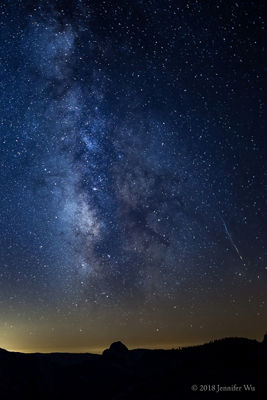
Meteor Showers
You can improve your odds of catching a shooting star with a little planning. An average night can have up to several meteors per hour, however the best time to capture meteor shots is during a meteor shower. There is often increased activity of meteors several days before the peak night of the meteor shower. In my experience, that can be a good time to photograph as well.
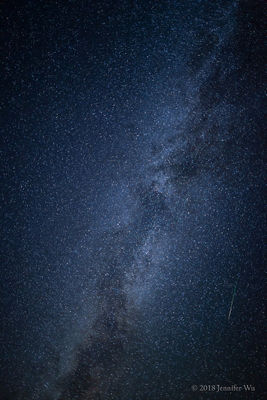
Meteor Shower Chart
Using several resources listed, I combined information for this chart for photographers to quickly look up if there is an upcoming meteor shower. [2] [3]
| Meteor Shower Name | Peak Date, each year* | Date Range | Time to Watch, 24hr | Peak Hourly Rate** | Radiant, Constellation & Direction | Visible Southern Hemisphere (SH) or Northern Hemisphere (NH) |
|---|---|---|---|---|---|---|
| Quadrantids | Jan. 3-4 | Dec. 26 – Jan. 12 | 23:00 to dawn | 60-120 | Boötes, near Big Dipper handle (N) | Faint, lasting a few hours, NH best |
| Lyrids | April 21-22 | April 16-26 | 21:30 to dawn | 10-15 | Lyra Constellation & Vega star (E) | Bright, NH, SH low rate |
| Eta Aquarids | May 5-6 | April 19 – May 28 | 01:30 to dawn | 20-75 | Aquarius (E) | Bright, best in SH and sparse in NH |
| Delta Aquarids | July 27-28 | 21:30 to dawn | 15-20 | Aquarius (S) | NH low rate, best in SH | |
| Perseids | Aug. 11-12 | July 17-Aug. 24 | Dusk to dawn | 60-100 | Perseus (NE) | Bright, fireballs, NH best, SH high in sky |
| Draconids | Oct. 7-8 | Just after sunset before nightfall | 10-100 | Draco; stars Eltanin & Rastaban (N & NW) | NH best, very high in the sky | |
| Orionids | Oct. 20-21 | Oct. 2 – Nov. 7 | 24:00 to dawn | 10-20 | Orion (SE) | NH, SH low rate |
| Taurids | Oct. 9-10 SH | Nov. 11-12 NH | 10-20 | Taurus (S) | Fireballs, SH, NH | ||
| Leonids | Nov. 17-18 | Month of Nov. | 23:30 to dawn | 10-15 | Leo (E) | High in the sky, NH & SH |
| Geminids | Dec. 13-14 | Dec. 4 -14 | 19:00 to dawn | 60-120 | Gemini (S) | NH best, SH medium rate |
| Ursids | Dec. 22-23 | 24:00 to dawn | 10 | Ursa Minor (N) | NH |
*The peak night can be off by a day or two depending on the year, check EarthSky.
**The per hour meteor listing only refers to the peak hour and not the hours before or after that hour. I see fewer meteors per hour than listed on the peak hour because some meteors are too faint to see and I am not looking 180 degrees. I get about two-dozen meteor photographs in a night of shooting with high rate meteor showers and good viewing conditions.
2018 Meteor Showers for Photographers
When looking for meteor showers to photograph, I first check for a high hourly peak rate. I then check the phase of the moon, looking for a shower near the new moon. Every year the moon phase will be different for each annual meteor shower. I looked up peak time with additional details on TimeandDate.com and the location in the sky with Stellarium. For meteor showers in future years, look up the same information.
Here is some information on upcoming meteor showers with good viewing conditions when the moon is not full.
- Perseids occurs from July 17 to August 24th. The peak night is August 12-13, 2018 and has a high rate of meteors. The peak is August 13th at 01h UTC. The crescent moon phase of 3% visibility allows for a dark sky and near perfect moon conditions! Plus it will set below the horizon before the peak hour. The Milky Way will be present in the sky too. Meteors will radiate from the constellation Perseus so look to the northeast for the radiant point. There is good viewing in both northern and southern hemispheres. This is an excellent meteor shower to photograph this year!
- Leonids occurs November 5 to 30th with the peak night November 17-18, 2018. The peak hour is November 17 at 23h UTC. The moon phase is 62% and the moon will be bright. However, photography is acceptable, though not ideal, after moonset. Meteors are strong around the pre-dawn hours when the moon will have set, allowing for better photographing conditions. The Leonids meteors are high in the sky, so look up and to the north. A vertical composition will increase chances of capturing meteors in the frame. Look to the constellation Leo the Lion for the meteors to radiate from. It is visible in both the northern and southern hemispheres. This is a good meteor shower for photographers this year.
- Geminids on the peak night of December 13-14th, will have a peak hour on December 14th at 13h UCT. It has a very high rate of meteors. The moon phase is 35% visible surface and this will provide some light on the landscape while still having meteors visible and photographable. Consider composing opposite the moon to get the moonlit landscape or sidelight from the moon by photographing with the moon just out of the frame. See my article Photographing the Moon for more information. Look to the constellation Gemini to the south. It is visible in the northern hemisphere and less so in the southern hemisphere. This is another excellent shower to photograph this year!
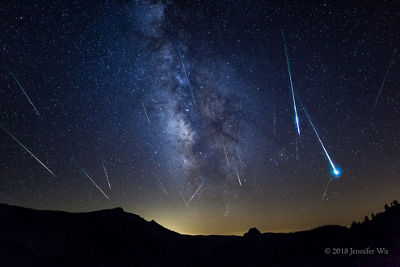
Northern & Southern Hemisphere Viewing
Meteor showers have a strong Northern Hemisphere bias for good viewing. Some meteor showers I recommend for photographers with high hourly meteor rates in the northern hemisphere are Perseids, Gemimids and also Leonids even though they are high in the sky with fewer meteors. For really big meteors and fireballs, I like photographing the Perseids and Taurids, even though they have fewer meteors.
I haven’t photographed meteor showers in the Southern Hemisphere. Based on my research for viewing in the Southern Hemisphere, the Eta Aquarids and Delta Aquarids are excellent. However, hourly rates for many other southern hemisphere meteor showers are visible but at reduced rates, such as the Orionids, Leonids, Geminids and Lyrids. The Quadrantids, Perseids and Draconids will not be visible at latitudes greater than forty degrees south. [1]
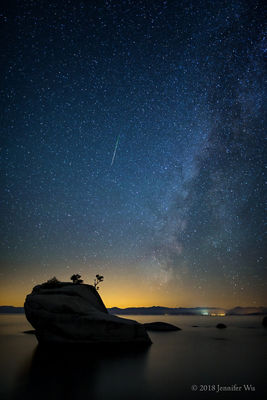
Meteor Shower Radiant Point
Meteors can appear in any part of the sky, including near the horizon or looking directly above. Be prepared to photograph in all directions during a shower. However most originate from the constellation that the meteor shower is associated with. The meteors appear to radiate out from that point in the sky near the constellation—hence, it’s called the radiant point. [3] If a meteor doesn’t radiate from that point, it is not a part of a meteor shower. As the constellation moves through the sky throughout the night, so will the radiant point. Once you get a couple of meteor shots, you can see where they radiate from and direction they point in the sky.
Find the constellation the meteor shower is associated with in the sky on the night of the peak by using the apps listed. Set the time throughout the night to see its path during the night. Plan your shoot in any direction, knowing where meteors will radiate from. Often the constellation associated with a meteor shower is below the horizon line at sunset and will appear at some point during the night. Hence, the peak viewing start time is often later in the evening. The best viewing for most meteor showers is in the predawn hours.
Locations
National and state parks usually provide dark skies with open views available. Look for a location higher in elevations for clearer skies. Check that your locations don’t get headlights that can light up your foreground and ruin your photograph. Scout your location before your shoot and compose with foreground in mind.
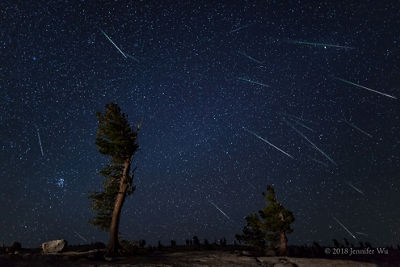
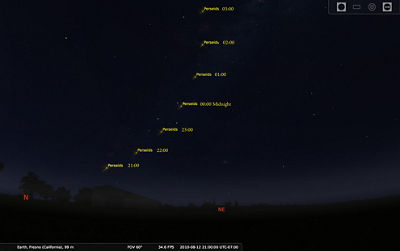
Creating Meteor Shower Composites
To combine the time-lapse images in Photoshop, select a base and all the meteor shots in Bridge or Lightroom® by pressing and holding the Control Key (PC) or Command Key (Mac) while selecting the images. From the Bridge select “Tools > Photoshop > Load Files” into Photoshop Layers. In Lightroom select “Photo > Edit In > Open as Layers in Photoshop.”
Click on your base layer and drag it to the bottom layer. Add a layer mask to the top meteor layer by clicking on the Add Layer Mask icon while holding the Alt/Opt key to hide the layer. Change the blend mode to “lighten” to allow the meteor to shine through and prevent dark sky areas from coming though. Remember the meteor location and paint in the meteor with a white brush at 100% opacity. (If needed, press the shift key and click on the layer mask icon to see the layer and hide it again.) Do this with all meteor layers for a beautiful meteor composite. Save your work as you go.
Is that a Plane or a Meteor?
Sometimes it is hard to tell if a streak across the sky is from a plane or a meteor and often workshop participants ask, “What is this?” Here is how what I look for.
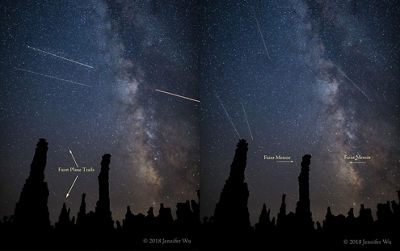
On Right: Meteors – This composite shows several meteors taken during a meteor shower. I noticed that meteors often start with a tapered green color, ending with a red or white tip. The meteor at the top of the frame starts green, turns yellow, then red or white at the base. Small meteors can look like planes. If you are unsure, review your image at 100% view — if the line starts abruptly, then it is a plane. If it starts with a green tapered tip, it is a meteor. Notice the difference between the faint green-colored meteors in this image versus the faint red and white plane trails of the image on the left.
Getting Prepared
Remember to have a fully charged battery and an extra, if available, for doing time-lapse. If it is cold, keep the backup battery warm in your pocket to preserve the shooting time on the battery. Have plenty of memory cards if you are going to do continuous shooting. Use a small red flashlight or red headlamp to preserve your night vision. When in the dark our eyes adjust to being able to see in dim light. Using a common flashlight or headlamp with white light will significantly reduce your night vision. It can take 30 minutes or longer for the ability to see at night in dim light to return. Bring what you need to keep yourself comfortable including: warm clothes, insect repellant, water, food, and something to sit on, as the ground can be cold.

Wishing you happy meteor showers and many wishes upon shooting stars!
Additional Resources
Apps: Determine sunrise and sunset times, phase of the moon, location of constellations in the sky for the radiant point:
Meteor Shower Calendar: free app from Google Play/Android or iTunes/iOS.
Starry Night desktop: I use this for planning
StarWalk 2: use this in the field for locating constellations by pointing your mobile device at the sky
Stellarium: free for desktop
PhotoPills: shows the night sky overlaid on a map of your location
The Photographer’s Ephemeris,/ and 3D: shows the night sky overlaid on a map of your location
American Meteor Society: meteor showers information guides and calendar
EarthSky: meteor shower calendar and guide
International Dark-Sky Association (IDA): help protect the night sky and dark sky locations
Online Class: Check out Jennifer's Online Learning class on Landscape Photography
TimeandDate.com: meteor shower dates and times
References
- NASA Meteor Guide
- NASA Meteor Shower Guide
- TimeandDate.com: meteor shower dates and times
All Canon contributors are compensated and actual users of Canon products promoted.




